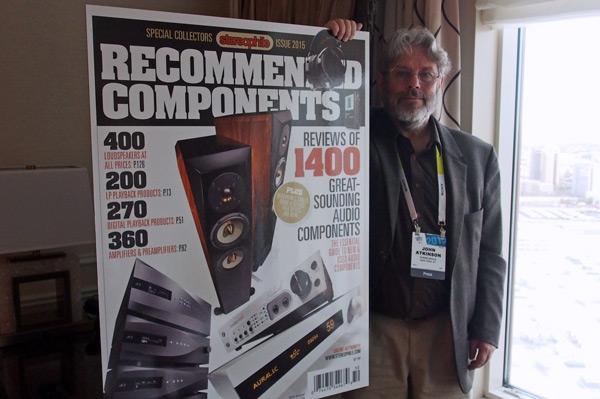| Columns Retired Columns & Blogs |
Nice photo! RD.

The results were interesting, with considerable similarities, but also some differences. Sandy Gross of GoldenEar Technologies suggested that for optimal imaging the distance between speakers should be at least as great as the distance from the listener and each speaker. One might think that this principle would be well-known and routinely followed by audiophiles, but apparently not so. Sandy said that one of his dealers complained to him that the GoldenEar Triton Twos did not produce as precise a soundstage as expected. It turned out that the dealer had set up the speakers in such a way that the distance between them was much less than the listener–speaker distances. Then, following Sandy's suggestion, the dealer moved the speakers further apart, and all of a sudden the soundstage came into focus.
Bryston's James Tanner made a similar argument, pointing out that if the speaker has a wide, uniform dispersion—like the ones made by Bryston —then the speakers can be placed further apart, producing a wider soundstage, with the sound reflected from the walls having the same spectral balance as the direct sound, maintaining a desirable uniform power response.
Mick Tillman of Dynaudio warned against making snap judgments of sound quality—with speakers or other components. He said you should take your time in making A/B comparisons, spending at least 10 minutes listening to each component before switching to the alternative. He also emphasized the importance of using various genres of music in the evaluation.
Frits Dalmose of Raidho Acoustics described a technique he finds useful in determining speaker positioning that does not involve speakers at all. Without there being any speakers in the room, he walks around the room, speaking and listening to the sound of his voice, noting where it sounds particularly boomy or thin, and where it sounds most natural, the latter positions being good candidates for speaker placement. He likes to place speakers closer to the side walls rather than the back wall, with the speakers toed in. In general, he feels that "you can't throw in a pair of speakers, no matter how good they are; if you don't do a good job [with the setup], you will not get good sound. "
At least as interesting as what manufacturers said about how to make their speakers sound their best was what they did not say. None of the manufacturers I spoke to suggested using particular cables, footers, etc. It seems that while these accessories can produce significant differences in sound quality, they're no magic bullet, no secret sauce that will transform a bad-sounding system into a good-sounding one.